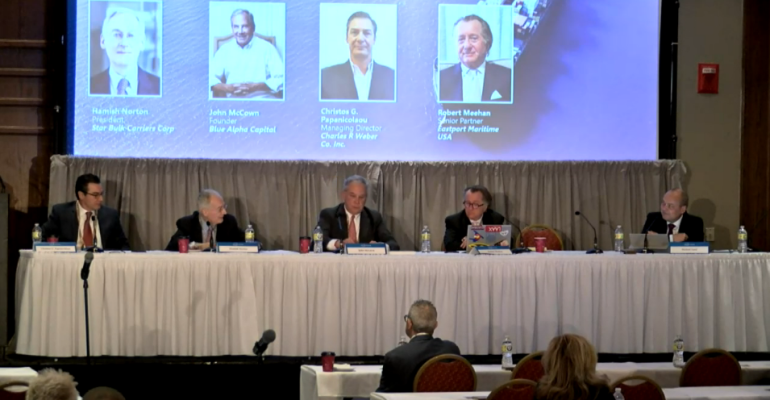Speaking at CMA Shipping 2022, experts on the panel Freight Markets: Past, Present and Future spoke of how markets had reacted to covid recovery, the war in Ukraine, and the drive for decarbonisation.
Star Bulk Carriers President, Hamish Norton, covered the impacts on the dry bulk market, and was upbeat. On the cargo side, the war in Ukraine has had a mixed impact. Grain flows have been disrupted and while countries are managing to find alternative sources from stockpiles for now, tonne-miles will be affected long term if Russian and Ukrainian grain does not come back to the market soon.
For coal, the impact has been positive as Europe turns its back on Russia as an origin and looks to other suppliers much further away like Australia.
“Dry bulk rates are good, the forward market is good. We're making money and frankly, the forward market suggests that we'll be making more money. Obviously the war is not something we would like to see continue,” said Norton.
Unlike the container market, higher bunker support the dry bulk sector as it puts pressure on charterers, who pay for the fuel, to cut speeds to save money on what generally less time-sensitive cargoes, said Norton.
“As fuel prices go up, the average speed of the fleet declines. It's like taking ships out of the market. Because the ships burn fuel approximately proportionally to the cube of the speed, you go a little slower, you burn a lot less fuel and that maximises your profit We do see speeds coming down... it's tightened supply and it brings charter rates up,” said Norton. For the same reasons, Norton sees decarbonisation as another supporting factor for dry bulk as slow steaming will prove an easy route to lower emissions for older vessels.
Speaking on the petrochemical market, Eastport Maritime USA Senior Partner, Robert Meehan, said that the war in Ukraine had a more complex impact on the market, especially when it came to the US.
As Sanctions landed on Russia, US producers prepared for a boom in demand for methanol from Europe, but that never happened.
“Why? Well, in part because there is a direct and indirect impact, notably on bunker prices. Bunker prices, the owners’ highest operating cost, went into the stratosphere, and with that freight rates went into the stratosphere as well. So we see a situation where methanol prices in Europe maybe increased $40-$50 a ton based on the sanctions, whereas the freight rate to get the product there increased $90 a ton,” said Meehan.
That sharp increase in costs softened European demand for US methanol, but Russia’s decision to force some nations to pay for natural gas in Roubles has driven up demand. Meehan expects demand for US methanol and feedstocks to continue to grow as it becomes less expensive to buy the products than make them in Europe.
Charles R. Weber Co. Inc Managing Director, Christos G. Papanicolaou covered dirty tankers and said it has taken around two months for the market to react to the restriction of Russia’s 9.9m bpd of oil exports. European buyers have increased purchases from the US, West Africa and Brazil, said Papanicolaou.
“With that oil being displaced—and unlike Hamish the price of oil does affect our business— the time equivalent earnings the companies are supposed to be making is affected by the price of bunkers.
“That's the biggest effect that we're seeing because ton miles are improving, but the cost of consumptions has risen so much that it's impacting the business for the tanker owners. We're expecting this to last throughout the summer,” said Papanicolaou.
Expecting Russia sanctions to stick around for some time, Papanicolau sees a new demand factor emerging as demand for non-Russian oil increases and inventories reach new lows.
“What we're seeing now is more and more demand for speed… it's telling you there's a sense of urgency. On the crude side and the product side, we’re seeing a new tonne-mile being developed that's not just distance but also speed, which affects our current trade.
“We're actually very optimistic that in the next one quarter, we'll continue seeing where things are due to the current Ukraine Russian crisis, but in the next three quarters, we see a large uptick in demand with a decrease in supply.”
Copyright © 2024. All rights reserved. Seatrade, a trading name of Informa Markets (UK) Limited.
Add Seatrade Maritime News to your Google News feed.  |

